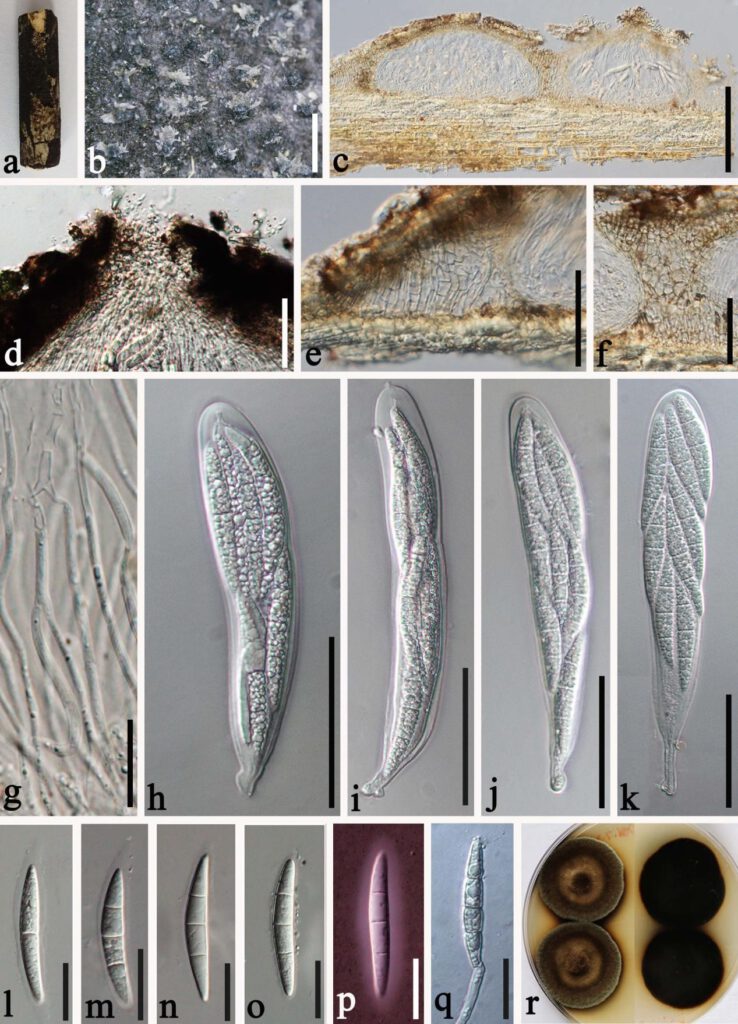Parabambusicola yunnanensis L.S. Han & D.Q. Dai, sp. nov.
MycoBank number: MB; Index Fungorum number: IF; Facesoffungi number: FoF 12952;
Holotype:GMB1291
Etymology: named after the Yunnan Province where the fungus was first discovered.
Saprobic on dead culm of bamboo. Sexual morph: Ascomata 300–500 μm diam. × 190–280 μm high, stromatic, gregarious, clustered in group, immersed under a black area, raised, with black spherical to hemispherical area on host surface, uniloculate, with a central ostiole (with 50–90 μm diam., 55–100 μm long), spores will be released to the surface of the ascomata and form white flocs after mature. Wall of locules 5–20 thick, comprising hosts and fungal tissues, thin, 8–15 µm wide, composed of hyaline cells of textura angularis, poorly developed at the base, fusing with host. Hamathecium comprising 1–2.5 μm wide, numerous, filamentous or slenderly cylindrical, septate, branched pseudoparaphyses. Asci 130–180 μm × 20–30 μm (x̄ =153 × 25 μm, n=20), bitunicate, fissitunicate, 8-spored, cylindrical to clavate, straight to slightly curved, apically rounded, with an obviously ocular chamber, short pedicellate, with furcate pedicel. Ascospores 40–55 μm × 5–8 μm (x̄ =48 × 7 μm, n=20), 2–3-seriate, 1–2-septate when immature, 3-septate when mature, guttulate, fusiform, slightly curved, hyaline, with a gelatinous sheath. Asexual morph: Undetermined.
Culture characteristics: Ascospores germinating on PDA within 24 h. Colonies reach 32 mm diam. in 15 days under dark and at 28 °C conditions. Colonies circular, hairy, entire edge, the color of the colonies center is light brown, the outward color gradually becomes dark, and the color of the margin is dark brown from above, dark brown from below.
Material examined: China, Yunnan Province, Dali, Cangshan mountain, (25°41′22″ N, 108°8′2″ E, 2381.26 m), on dead culm of bamboo, 11 July 2021, D. Q. Dai, DDQ02030 (GMB1291, holotype), living culture, ex-type GMBCC1128; Ibid. (ZHKU22-0158 isotype), ex-isotype ZHKUCC 22-0290.
Notes: The genus Parabambusicola was introduced by Tanaka et al. (2015), currently, it comprises four species (viz., P. aquatica, P. bambusina, P. hongheensis, and P. thysanolaenae) (Tanaka et al. 2015, Phookamsak et al. 2019, Dong et al. 2020, Xie et al. 2022). The morphology of newly collection conforms to the general characteristics of Parabambusicola in immersed, hemispherical, raised ascomata, 8-spored, cylindrical, short pedicellate, furcate pedicel asci with an obviously ocular chamber, hyaline, fusiform ascospores (Tanaka et al. 2015, Phookamsak et al. 2019, Dong et al. 2020, Xie et al. 2022). In this study, the new collection can be distinguished from the other four species in having 3-septate ascospores (Table 2). The phylogenetic tree also proved the new strains formed a separate branch with well-separated lineage in Parabambusicola s. str. (100% ML and 1.00 PP, Figure 1). Based on morphological and phylogenetic studies, our new collection of Parabambusicola was introduced as a new species in bamboo from China.

FIGURE 2. Parabambusicola yunnanensis (GMB1291, holotype). a. Bamboo specimen. b. Black ascostromata on the host surface. c. Vertical sections of ascomata. d. Ostiole. e. Cells of ascostromatic and loculate wall. f. Cells between locules. g. Pseudoparaphyses. h−k. Asci. l−o. Ascospores. p. An ascospore in India ink. q. A germinating ascospore. r. Cultures on PDA from above and below. Scale bars: b = 500 μm; c = 300 μm; d, k−h = 50 μm; e−g = 15 μm; l−q = 20 μm.
